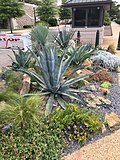Xeriscaping
Xeriscaping is a method of landscape design or garden design that minimizes water use. It is promoted in regions that do not have easily accessible, plentiful, or reliable supplies of fresh water, and is gaining acceptance in other regions as water becomes more limited. Xeriscaping may be an alternative to various types of traditional gardening.
Definition and etymology[edit]
The term Xeriscaping is a portmanteau of xeros (Greek for "dry") and landscaping, and was coined by the Denver Water Department in 1981 as a method of promoting water conservation in landscapes.
Principles[edit]
Xeriscaping is based on seven principles, which include planning and design, selection of plants, soil analysis, practical turf areas, efficient irrigation, use of mulches, and appropriate maintenance.
Benefits[edit]
The primary benefit of xeriscaping is water conservation. Xeriscaping can reduce landscape water use by 50 – 75%. Other benefits can include reduced maintenance and waste, increased property value, and reduced need for pesticides and fertilizers.
Criticisms[edit]
Despite its benefits, xeriscaping has been criticized for its potential to harm local wildlife and for its aesthetic. However, many xeriscaping advocates argue that these criticisms are based on misconceptions.
See also[edit]

This article is a horticulture stub. You can help WikiMD by expanding it!

This article is a sustainability-related stub. You can help WikiMD by expanding it!

This article is a water supply–related stub. You can help WikiMD by expanding it!
-
Xeriscaping at the US Capitol
-
Xeriscape Demonstration Garden
-
Opuntia in bloom
-
Al Norris Memorial Xeriscape Garden
Ad. Transform your life with W8MD's Budget GLP-1 injections from $75


W8MD offers a medical weight loss program to lose weight in Philadelphia. Our physician-supervised medical weight loss provides:
- Weight loss injections in NYC (generic and brand names):
- Zepbound / Mounjaro, Wegovy / Ozempic, Saxenda
- Most insurances accepted or discounted self-pay rates. We will obtain insurance prior authorizations if needed.
- Generic GLP1 weight loss injections from $75 for the starting dose.
- Also offer prescription weight loss medications including Phentermine, Qsymia, Diethylpropion, Contrave etc.
NYC weight loss doctor appointmentsNYC weight loss doctor appointments
Start your NYC weight loss journey today at our NYC medical weight loss and Philadelphia medical weight loss clinics.
- Call 718-946-5500 to lose weight in NYC or for medical weight loss in Philadelphia 215-676-2334.
- Tags:NYC medical weight loss, Philadelphia lose weight Zepbound NYC, Budget GLP1 weight loss injections, Wegovy Philadelphia, Wegovy NYC, Philadelphia medical weight loss, Brookly weight loss and Wegovy NYC
|
WikiMD's Wellness Encyclopedia |
| Let Food Be Thy Medicine Medicine Thy Food - Hippocrates |
Medical Disclaimer: WikiMD is not a substitute for professional medical advice. The information on WikiMD is provided as an information resource only, may be incorrect, outdated or misleading, and is not to be used or relied on for any diagnostic or treatment purposes. Please consult your health care provider before making any healthcare decisions or for guidance about a specific medical condition. WikiMD expressly disclaims responsibility, and shall have no liability, for any damages, loss, injury, or liability whatsoever suffered as a result of your reliance on the information contained in this site. By visiting this site you agree to the foregoing terms and conditions, which may from time to time be changed or supplemented by WikiMD. If you do not agree to the foregoing terms and conditions, you should not enter or use this site. See full disclaimer.
Credits:Most images are courtesy of Wikimedia commons, and templates, categories Wikipedia, licensed under CC BY SA or similar.
Translate this page: - East Asian
中文,
日本,
한국어,
South Asian
हिन्दी,
தமிழ்,
తెలుగు,
Urdu,
ಕನ್ನಡ,
Southeast Asian
Indonesian,
Vietnamese,
Thai,
မြန်မာဘာသာ,
বাংলা
European
español,
Deutsch,
français,
Greek,
português do Brasil,
polski,
română,
русский,
Nederlands,
norsk,
svenska,
suomi,
Italian
Middle Eastern & African
عربى,
Turkish,
Persian,
Hebrew,
Afrikaans,
isiZulu,
Kiswahili,
Other
Bulgarian,
Hungarian,
Czech,
Swedish,
മലയാളം,
मराठी,
ਪੰਜਾਬੀ,
ગુજરાતી,
Portuguese,
Ukrainian



